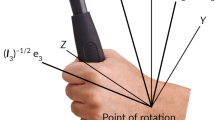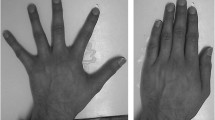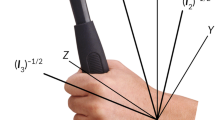Abstract
Individuals can perceive the properties of an attached or grasped object by wielding it through muscular effort—an ability referred to as dynamic or effortful touch. Sensitivity to the forces required to move such objects and to the resulting global patterns of tissue deformation underlies such perception. Given that perception via dynamic touch is movement-based, we hypothesized that manipulations that affect the ability to produce and control muscular movements might affect perception via dynamic touch. Cooling muscles from 40 to 10 °C impedes the development and transmission of muscular force and diminishes muscle stretch-reflex sensitivity. Accordingly, we anticipated that changes in hand temperature would alter the ability to detect patterns of tissue deformation and thus perception of the properties of wielded objects. In two experiments, participants wielded dowels with different lengths and rotational inertias (Experiment 1) and objects with identical lengths and different rotational inertias (Experiment 2). They reported perceived lengths of these objects, in the absence of vision, in cool (~ 10 °C), neutral (~ 30 °C), and warm temperature conditions (~ 40 °C). Actual length predicted perceived length of the dowels (Experiment 1), and rotational inertia predicted perceived length of the objects (Experiment 2); perceived lengths were longer in the warm condition than in the cool condition. In consideration of known temperature-induced changes in tissue structure and function, our results support the hypothesis that comparable processes underlie the control of movement and perception via dynamic touch.

Adapted from Mangalam et al. (2007). Copyright 2017 by the Springer US

Adapted from Mangalam et al. (2007). Copyright 2017 by the Springer US





Similar content being viewed by others
References
Bernstein NA (1967) The co-ordination and regulation of movement. Pergamon, Oxford
Bernstein NA, Latash ML, Turvey MT (1996) Dexterity and its development. Lawrence Erlbaum, Marwah
Burton G, Turvey MT (1990) Perceiving the lengths of rods that are held but not wielded. Ecol Psychol 2:295–324. https://doi.org/10.1207/s15326969eco0204_1
Burton G, Turvey MT, Solomon HY (1990) Can shape be perceived by dynamic touch? Percept Psychophys 48:477–487. https://doi.org/10.3758/BF03211592
Carello C, Turvey MT (2000) Rotational invariance and dynamic touch. In: Heller MA (ed) Touch, representation and blindness. Oxford University Press, New York, pp 27–66
Carello C, Fitzpatrick P, Domaniewicz I et al (1992) Effortful touch with minimal movement. J Exp Psychol Hum Percept Perform 18:290–302. https://doi.org/10.1037/0096-1523.18.1.290
Carello C, Thuot S, Turvey MT (2000) Aging and the perception of a racket’s sweet spot. Hum Mov Sci 19:1–20. https://doi.org/10.1016/S0167-9457(99)00044-5
Carello C, Kinsella-Shaw J, Amazeen EL, Turvey MT (2006) Peripheral neuropathy and object length perception by effortful (dynamic) touch: a case study. Neurosci Lett 405:159–163. https://doi.org/10.1016/j.neulet.2006.06.047
Carello C, Silva PL, Kinsella-Shaw JM, Turvey MT (2008) Muscle-based perception: theory, research and implications for rehabilitation. Braz J Phys Ther 12:339–350. https://doi.org/10.1590/S1413-35552008000500002
Clarke RSJ, Hellon RF, Lind AR (1958) The duration of sustained contractions of the human forearm at different muscle temperatures. J Physiol 143:454–473. https://doi.org/10.1113/jphysiol.1958.sp006071
Cooper MM, Carello C, Turvey MT (2000) Perceptual independence of whole length, partial length, and hand position in wielding a rod. J Exp Psychol Hum Percept Perform 26:74–85. https://doi.org/10.1037/0096-1523.26.1.74
Cornwall MW (1994) Effect of temperature on muscle force and rate of muscle force production in men and women. J Orthop Sport Phys Ther 20:74–80. https://doi.org/10.2519/jospt.1994.20.2.74
de Ruiter CJ, Jones DA, Sargeant AJ, de Haan A (1999) Temperature effect on the rates of isometric force development and relaxation in the fresh and fatigued human adductor pollicis muscle. Exp Physiol 84:1137–1150
Fitzpatrick P, Carello C, Turvey MT (1994) Eigenvalues of the inertia tensor and exteroception by the “muscular sense”. Neuroscience 60:551–568. https://doi.org/10.1016/0306-4522(94)90264-X
Gibson JJ (1966) The senses considered as perceptual systems. Houghton Mifflin, Boston
Gibson JJ (1979) The ecological approach to visual perception. Houghton Mifflin, Boston
Hajnal A, Fonseca S, Harrison S et al (2007a) Comparison of dynamic (effortful) touch by hand and foot. J Mot Behav 39:82–88. https://doi.org/10.3200/JMBR.39.2.82-88
Hajnal A, Fonseca S, Kinsella-Shaw JM et al (2007b) Haptic selective attention by foot and by hand. Neurosci Lett 419:5–9. https://doi.org/10.1016/j.neulet.2007.03.042
Jarmey C, Sharkey J (2003) The concise book of muscles. North Atlantic Books, Berkeley
Jones LA, Lederman SJ (2006) Human hand function. Oxford University Press, New York
Kenshalo DRS (1986) Somesthetic sensitivity in young and elderly humans. J Gerontol 41:732–742. https://doi.org/10.1093/geronj/41.6.732
Mangalam M, Barton SA, Wagman JB et al (2017) Perception of the length of an object through dynamic touch is invariant across changes in the medium. Atten Percept Psychophys 79:2499–2509. https://doi.org/10.3758/s13414-017-1403-9
Michalski WJ, Séguin JJ (1975) The effects of muscle cooling and stretch on muscle spindle secondary endings in the cat. J Physiol 253:341–356. https://doi.org/10.1113/jphysiol.1975.sp011193
Mountcastle VB (2005) The sensory hand. Harvard University Press, Cambridge
Ottoson D (1965) The effects of temperature on the isolated muscle spindle. J Physiol 180:636–648. https://doi.org/10.1113/jphysiol.1965.sp007721
Pagano CC, Cabe PA (2003) Constancy in dynamic touch: length perceived by dynamic touch is invariant over changes in media. Ecol Psychol 15:1–17. https://doi.org/10.1207/S15326969ECO1501_01
Pagano CC, Donahue KG (1999) Perceiving the lengths of rods wielded in different media. Percept Psychophys 61:1336–1344. https://doi.org/10.3758/BF03206184
Pagano CC, Turvey MT (1992) Eigenvectors of the inertia tensor and perceiving the orientation of a hand-held object by dynamic touch. Percept Psychophys 52:617–624. https://doi.org/10.3758/BF03211699
Pagano CC, Fitzpatrick P, Turvey MT (1993) Tensorial basis to the constancy of perceived object extent over variations of dynamic touch. Percept Psychophys 54:43–54. https://doi.org/10.3758/BF03206936
Pagano CC, Kinsella-Shaw JM, Cassidy PE, Turvey MT (1994) Role of the inertia tensor in haptically perceiving where an object is grasped. J Exp Psychol Hum Percept Perform 20:276–285. https://doi.org/10.1037/0096-1523.20.2.276
Palatinus Z, Carello C, Turvey MT (2011) Principles of part-whole selective perception by dynamic touch extend to the torso. J Mot Behav 43:87–93. https://doi.org/10.1080/00222895.2010.538767
Parsons K (2002) Human thermal environments. CRC, Boca Raton
Ranatunga KW, Sharpe B, Turnbull B (1987) Contractions of a human skeletal muscle at different temperatures. J Physiol 390:383–395. https://doi.org/10.1113/jphysiol.1987.sp016707
Schleip R, Findley T, Huijing P (2012) Fascia: the tensional network of the human body. Elsevier, New York
Shaffer SW, Harrison AL (2007) Aging of the somatosensory system: a translational perspective. Phys Ther 87:193–207
Solomon HY, Turvey MT, Burton G (1989) Perceiving extents of rods by wielding: haptic diagonalization and decomposition of the inertia tensor. J Exp Psychol Hum Percept Perform 15:58–68. https://doi.org/10.1037/0096-1523.15.1.58
Stevens JC, Choo KK (1996) Spatial acuity of the body surface over the life span. Somatosens Mot Res 13:153–166. https://doi.org/10.3109/08990229609051403
Turvey MT, Carello C (2011) Obtaining information by dynamic (effortful) touching. Philos Trans R Soc London B Biol Sci 366:3123–3132. https://doi.org/10.1098/rstb.2011.0159
Turvey MT, Fonseca ST (2014) The medium of haptic perception: a tensegrity hypothesis. J Mot Behav 46:143–187. https://doi.org/10.1080/00222895.2013.798252
Turvey MT, Burton G, Pagano CC et al (1992) Role of the inertia tensor in perceiving object orientation by dynamic touch. J Exp Psychol Hum Percept Perform 18:714–727. https://doi.org/10.1037/0096-1523.18.3.714
Turvey MT, Burton G, Amazeen EL et al (1998) Perceiving the width and height of a hand-held object by dynamic touch. J Exp Psychol Hum Percept Perform 24:35–48. https://doi.org/10.1037/0096-1523.24.1.35
van der Wal JC, Drukker J (1988) The occurrence of muscle spindles in relation to the architecture of the connective tissues in the lateral cubical region of the rat. In: Hník P, Soukup T, Vejsada R, Zelená J (eds) Mechanoreceptors: development, structure, and function. Springer, Boston, pp 345–346
Waddell ML, Amazeen EL (2017) Evaluating the contributions of muscle activity and joint kinematics to weight perception across multiple joints. Exp Brain Res 235:2437–2448. https://doi.org/10.1007/s00221-017-4979-3
Wagman JB, Abney DH (2012) Transfer of recalibration from audition to touch: modality independence as a special case of anatomical independence. J Exp Psychol Hum Percept Perform 38:589–602
Wagman JB, Hajnal A (2014a) Task specificity and anatomical independence in perception of properties by means of a wielded object. J Exp Psychol Hum Percept Perform 40:2372–2391. https://doi.org/10.1037/xhp0000014
Wagman JB, Hajnal A (2014b) Getting off on the right (or left) foot: perceiving by means of a rod attached to the preferred or non-preferred foot. Exp Brain Res 232:3591–3599. https://doi.org/10.1007/s00221-014-4047-1
Wagman JB, Langley MD, Higuchi T (2017) Turning perception on its head: cephalic perception of whole and partial length of a wielded object. Exp Brain Res 235:153–167. https://doi.org/10.1007/s00221-016-4778-2
Author information
Authors and Affiliations
Contributions
MM and KMN conceived and designed research; MM performed experiments; MM analyzed data; MM and JBW interpreted results of experiments; MM prepared figures; MM, JBW, and KMN edited and revised manuscript; MM, JBW, and KMN approved final version of manuscript.
Corresponding author
Ethics declarations
Conflict of interest
The authors declare that no competing interests exist.
Rights and permissions
About this article
Cite this article
Mangalam, M., Wagman, J.B. & Newell, K.M. Temperature influences perception of the length of a wielded object via effortful touch. Exp Brain Res 236, 505–516 (2018). https://doi.org/10.1007/s00221-017-5148-4
Received:
Accepted:
Published:
Issue Date:
DOI: https://doi.org/10.1007/s00221-017-5148-4




